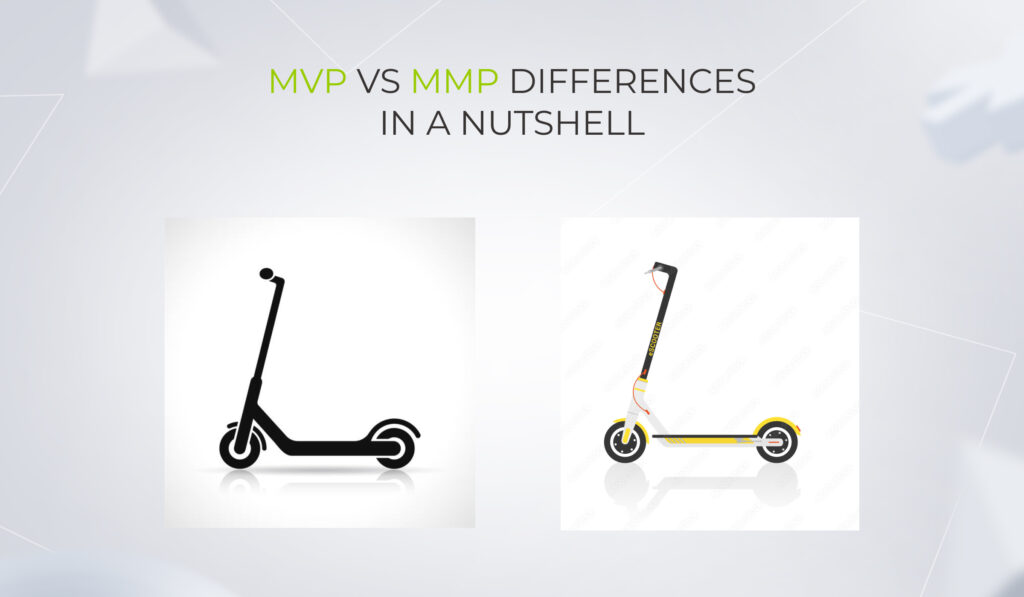Contents
MVP vs. MMP development – which is worth investing in? Stakeholders face this dilemma when coming up with the idea of a brand-new digital product or exploring ways to build on top of an existing solution.
Where do a minimum viable product and a minimum marketable one fit in the software product development path? Can you leverage MMP and MVP concepts, or do you have to pick one option and stick to it as your North Star? And more importantly, let’s talk money — which approach can your business cash in on? Our experts’ battle-tested experience will help to make the right choice.
Contrast or cohesion: what is the difference between MMP and MVP?
Right off the bat: MVP and MMP aren’t opposites. In the Agile approach, they represent consecutive phases of the software product development process.
Imagine a basic self-riding scooter. Minimum features, no frills. That’s your MVP. It’s all about giving early adopters a taste, a hook — something they can’t resist even if it isn’t perfect and has limited functionality. It’s the spark that ignites their interest despite its raw design. MVP’s charm? It gets users moving through the city. And as a scooter innovator, it’s your golden ticket to leverage validated learning, gather real-world feedback from the product’s initial users, and evolve.
Now, let’s upgrade.
Enter the MMP. Think electric scooter: sleeker design, adjustable handlebars, and the thrill of choosing between multiple speeds. It’s not just about mobility anymore — it’s about zooming around town in style, tailored to target users’ individual preferences. The MMP isn’t a rough draft. It’s a polished piece with new features, primed to conquer the market and meet user needs with its enhanced value proposition. Plus, it tackles distribution challenges head-on.
In essence, while an MVP is the product’s early version with just enough features to capture initial interest, an MMP is the showstopper – refined, feature-rich, and ready for the spotlight.

Decoding MMP vs MVP: a face-to-face analysis
Even though MVP and MMP are rungs of the same product development ladder, it still makes sense to gauge them against various parameters. Consider that choosing one option over the other may have a knock-on effect on the desirable outcome.
1. Purpose and focus
MVP’s primary purpose is confirming your product’s viability, checking the product-market fit, gathering the first real feedback, and identifying areas for improvement. MVP also empowers companies in their startup phase, seeking investors’ financing support, to be more convincing.
When crafting a minimum viable product, a dedicated team has a narrow focus on laying the groundwork for the future final version of full-fledged software.
Generating revenue isn’t necessarily a goal at this stage. Yet, if your product is groundbreaking, odds are high for profits to roll in. Maybe you’ll be the next unicorn startup to join the ranks of successful minimum viable products that hit it big with no-frills MVPs, such as Spotify, Uber, and Airbnb.
As for MMP, its paramount purpose is a successful product launch and drawing customers’ attention to it. Along with product development, it focuses on marketing activities to promote the solution.
2. Target audience
MVP is directed towards early adopters or potential investors if you’re looking for additional funding to develop your product idea.
You can test the MVP concept on your established users if you run a company with a loyal customer base.
One of our clients – a healthcare corporation – developed MVPs to release to their devoted clients first. Not only did those clients gain access to the new products and features ahead of the rest, but the company reaped the rewards of detailed feedback from engaged users.
— Konstantin Nikitin, Lead Project Manager, *instinctools
MMP aims to engage a broad audience of end users. Backed by blow-by-blow market research, you should know your target users better than anyone — what customer expectations have to be met, what pain points need to be addressed, etc., to enable surefire market entrance.
3. Feature set
You don’t need to build a penthouse if all your customers want is a camping tent.
Keep this in mind when crafting your MVP, as its essence is in simplicity and precision.
Our recent collaboration with our client, SpexAI, in developing the MVP of the frontline AgTech solution has once again proven it to be the right approach. We didn’t drown in features. Instead, we sharpened our focus on a singular game-changer: real-time monitoring of nutrient levels in crops.
When it comes to MVP vs. MMP comparison regarding their functional diversity, MMP truly shines. Packed with a richer array of features, minimum marketable product not only provides end-users with key features but also brilliantly caters to a wider spectrum of customer expectations and requirements, and tackles market demand more efficiently.
For instance, here’s how PillPack – an online pharmacy – has rewired the shopping experience for elderly patients with an MMP. Pre-sorted packaging allows each client to receive their medicines arranged according to the individual intake schedule. PillPack’s MMP also covers home delivery, eliminating those pesky pharmacy visits. Add to that effortless collaboration with insurance companies, which simplifies purchasing drugs, and you’ll get the product that wins customers’ hearts and wallets.
4. Development time & cost
Being built around a single killer feature, MVP development spans 2 to 6 months, making it a faster and often more cost-effective option compared to a full-blown MMP. However, the time frame can vary based on the project’s intricacies. For instance, if a company reuses its existing solution with legacy architecture for an MVP, the development process might take longer.
With an MMP, which can take place after MVP rollout, you have to consider time for implementing should-have and could-have features.
So, any way you slice it, crafting a minimum marketable product takes more time and money, than developing a minimum viable product.
5. Risks
MVP and MMP are not just idle undertakings. Think of them as your protective shields against massive expenses and risky ventures. Instead of pouring heaps of money into a full-blown product, MVP and MMP offer a savvy path, ensuring you don’t break the bank or release something that doesn’t resonate with users and can’t generate revenue.
But here’s the fun twist: an MVP, as a minimal offering, is like a sneak peek for early adopters. Even if it’s not perfect, you’ve got a golden opportunity to jazz it up based on the user feedback. It’s your solution’s debut, yet, with room for improvement.
But an MMP? It’s out there for a vast audience, and first impressions matter big time. No do-overs, no second acts to captivate users with your product.
6. Monetization and revenue
Even though the direct purpose of an MVP is to confirm the product’s viability and gather feedback from the early adopters for further development, it doesn’t mean it can’t bring you tangible value. Gartner warns against underpricing the MVP or positioning it as a freemium version of the product unless you use a freemium strategy.
If your solution with minimal features can be monetized and bring you ROI without investing a bundle of money in marketing promotion, such an opportunity shouldn’t be sniffed at.
— Konstantin Nikitin, Lead Project Manager, *instinctools
Unlike the MVP, which only lays the foundation for the future product, the MMP captivates a wider audience and is meticulously crafted to drive monetization and boost revenue. As MMP is closer to a full-fledged final product in terms of functionality and UX than MVP, its ROI potential is higher.
7. Marketing investments
MVP is the most cost-conscious option you can choose, as you invest only in software development. Banking on it in the MVP vs. MMP puzzle empowers you to keep the budget in check and save more of it for the upcoming feature releases and product fine-tuning.
There’s a reason for the second ‘M’ in the MMP — it stands for ‘marketable’, implying marketing investments.
Odoo is a living example of a successful minimum marketable product that invested in marketing promotion ⅔ of the funds raised from investors and managed to get into high gear. Now it can compete with ERP titans.
On the flip side, MMP’s expensive launch may consume budgets, leaving insufficient resources to launch the complex product later properly.
We’ve rounded up MMP vs. MVP key differences in a brief table to make it easier for you to grasp these two concepts.
| Criteria | MVP | MMP |
| Purpose and focus | – Confirming your product’s viability – Checking the product-market fit – Gathering the first real feedback – Identifying areas for improvement | – Checking if all the areas for improvement are covered, and primary should-have and could-have features are implemented alongside the must-have ones – Gathering feedback from a wide range of actual customers – Conquering the market |
| Target audience | Early adopters or potential investors for startups — a loyal customer base of midsize companies and enterprises. | Any end user |
| Feature set | Must-have features only | Must-have, should-have, and could-have features to ensure market success |
| Development time & cost | It typically takes 2 to 6 months to craft an MVP and costs less compared to MMP | Requires more time and investments as it involves developing more than the bare minimum features and planning marketing activities |
| Risks | You always have room for improvement based on the early adopters’ feedback | You have to be quite sure that your product will pan out, as MMP is introduced to a wide audience and won’t have a second chance to reel in users |
| Monetization and revenue | Can be monetized and bring ROI, but, in the first place, is designed to check the product’s viability | Is designed for monetization and delivering quantifiable value and revenue |
| Marketing investments | Doesn’t include marketing activities | Requires marketing investment |
Real-world examples of MVP vs MMP: when one approach works over another
McKinsey unveils that only 20% of start-ups reach product and market fit and can boast about hitting it big. Although each situation calls for unique approaches, not the standard playbook, you can learn from other established businesses’ experience. Here are two stories of the *instinctools’ clients.
- Social media startup picks MMP over MVP to enter a highly competitive market
That’s one of the projects we are currently working on. A client reached us with an idea of a new social media platform. At first, they wanted to develop an MVP. However, given that there are a lot of established players in this field, it would be challenging to entice users with just some basic features.
Therefore, the client decided to craft a more advanced solution and up their game with marketing promotion to highlight the launch of a new social media platform to a broader audience.
- An innovative startup conquers the market with an MVP for aggregating EV charging points
Another client, Bonnet, considered going with an MMP from the start. However, as they were a trailblazer with a laser-focused mobile application for gathering EV charging points all over Europe, at first, there was no need for extensive functionality and a large-scale advertising campaign for the app. Therefore, they opted for MVP development and reallocated the funds earmarked for marketing activities for the product’s future versions and releases.
And it was a smart choice. Even the pilot version of the app turned out to be just what the market and users were hungry for. The MVP received support from prominent and influential investors like Lightspeed Venture Partners, Tier Mobility, Wise, etc., and from the product’s initial users, who were willing to participate in Bonnet’s crowdfunding campaign. The company exceeded the goal with 115% of capital raised and continues its thriving growth across the UK and Europe.
Choosing between or going from MVP to MMP
While MVP and MMP aren’t the final versions of a product, they are key players when it comes to testing the market waters.
An MVP allows you to pilot your idea, securing genuine feedback without breaking the bank.
On the other hand, an MMP is your ticket to rapidly wooing customers and accelerating your ROI.
If you aren’t tight on budget, why not let MMP use MVP as a launchpad for a double impact?
The good thing is that you don’t have to deal with the MMP vs. MVP dilemma on your own either way. Partnering with an MVP development company in USA ensures you have the right expertise to navigate the transition smoothly. With a reliable tech ally by your side, you are doomed to succeed.
Are you still in two minds?
FAQ
An MVP is a pilot version with a single killer feature that reflects an idea of a future final product and requires minimum investment. It’s a sneak peek at the solution to get feedback from early adopters and/or to attract investors and prove that your idea is worth their financial support.
An MMP is a version of a product you can introduce to end users being sure that it will have a positive impression on them. MMP is more feature-rich than MVP and, along with investments in development, should include a budget for marketing promotion.
For an MVP, you have to identify must-have features and center on them, while with an MMP, you need to take care of should-have and could-have features on top of the core one. This difference in feature prioritization impacts the development process as well – you’ll need more sprints to develop and test the features above the bare minimum with the MMP.
Both an MVP and MMP can put your business on the fast track to success. In both cases, you start with a small feature set and move iteratively, staying in the loop of customers’ feedback. That way, you ensure crafting a product your target audience is hungry for.
Validating the product’s idea is one of the primary purposes of an MVP. It’s designed to confirm the product’s viability by gathering and analyzing feedback from early adopters. And MMP aims to prove that end users will accept the product.
For an MVP, feedback from the early adopters is a guiding star to unveil the areas for improvement before releasing your product to end users. And for an MMP, user feedback is the way to evaluate what kind of first impression the product has made and measure the product’s success.
The choice between MVP vs. MMP depends on a number of criteria — your target customers, purpose and focus of the product’s development, your budget, and if it can cover activities besides development, available time for crafting a software product, expectations of the product’s monetization, acceptable risk level, etc.
Don’t bite off more than you can chew – this principle can be applied to software product development. MVP and MMP are close and related stages in the product’s SDLC but aren’t the same. You can craft a few MVPs that will later become an MMP’s components.



